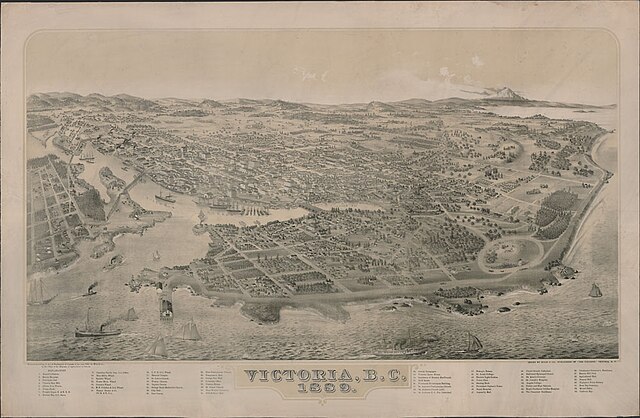The Chinatown in Victoria, British Columbia is the oldest Chinatown in Canada and the second oldest in North America after San Francisco. Victoria's Chinatown had its beginnings in the mid-nineteenth century in the mass influx of miners from California to what is now British Columbia in 1858. It remains an actively inhabited place and continues to be popular with residents and visitors, many of whom are Chinese-Canadians. Victoria's Chinatown is now surrounded by cultural, entertainment venues as well as being a venue itself. Chinatown is now conveniently just minutes away from other sites of interests such as the Save-On-Foods Memorial Centre, Bay Centre, Empress Hotel, Market Square, and others.
Chinatown, with the Gate of Harmonious Interest in the background
The Gate of Harmonious Interest was erected in the 1980s, as a part of a larger revitalization effort.
Chinatown is presently a popular area for tourists, consisting of several historical sites, including Fan Tan Alley.
Victoria, British Columbia
Victoria is the capital city of the Canadian province of British Columbia, on the southern tip of Vancouver Island off Canada's Pacific coast. The city has a population of 91,867, and the Greater Victoria area has a population of 397,237. The city of Victoria is the seventh most densely populated city in Canada with 4,406 inhabitants per square kilometre (11,410/sq mi).
From the top, left to right: the British Columbia Parliament Buildings; Downtown Victoria; Craigdarroch Castle; Christ Church Cathedral; the Empress Hotel; and the Float Home Village at Fisherman's Wharf
View of Victoria from James Bay in 1862. The city was incorporated that year as a result of the Fraser Canyon Gold Rush.
Royal Canadian Naval Volunteer Reserve members stand outside the British Columbia Parliament Buildings in 1914
Bird's-eye view of Victoria in 1889. After the completion of the Canadian Pacific Railway in 1886, Victoria lost its position as the commercial centre of the province to Vancouver.







